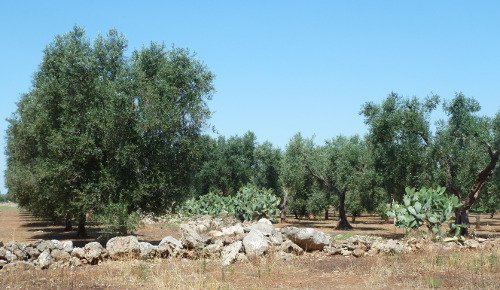
A great attention in the Apulia region to the problem. But it’s starting to become a reason of concern in other European countries, such as France and Spain. Fears and worries of people that see the olive tree heritage in danger are now focused on Xylella fastidiosa. Science is trying to find new innovative tools in order to provide useful solutions: plant-based sensors, climate predictions, infection analyses from leaf level to the landscape scale. The CMCC Foundation is at the forefront – with researchers and technologies – to provide diagnosis, early detection methods and effective analyses to tackle and prevent the infection outbreak.
In this region Xylella fastidiosa, that is the bacterium associated with the severe disorder responsible for declining olive trees, has never been detected before. The first symptoms were recorded in 2008, and then since 2013 a severe outbreak began spreading in the Salento area, while reaching more recently France (Corsica and Mainland France in the area near Nice) and Spain (Balearic Islands). It’s something new in Italy and Europe and now international research teams, multidisciplinary strategies, different methods and approaches are at work in order to find efficient solutions to understand this issue while studying its spreading and underlying how to defeat it.
The CMCC Foundation is dealing in activities that combine the contribution of agronomists and ecologists with climate simulations, plant phenological patterns and data analyses of the CMCC Supercomputing Center (in Lecce, Italy) in order to assess plant vulnerability to the disease.
Among its priorities, the development of techniques to improve early detection and control of Xylella fastidiosa at different levels, from leaf level to the landscape scale. It’s what it’s going on in the framework of XF – ACTORS, a multidisciplinary project funded by the European union and coordinated by the CNR (Bari headquarters, Istituto per la Protezione Sostenibile delle Piante – IPSP) in which many research institutions, including the CMCC Foundation, are involved. More in detail, the CMCC Foundation will design and develop some impact models to assess olive tree vulnerability. “We will use some sensors installed on the trunk of the olive trees”, explains Monia Santini, CMCC Foundation researcher. “Trunk sensors will allow us to acquire data in continuum, in particular eco-physiological traits and plant characteristics such as temperature and trunk diameter changes, sap viscosity and speed, light levels in foliage”. These parameters will help in monitoring plant conditions while identifying healthy plants more susceptible to disease due to surrounding environmental conditions, and plants with the first symptoms of the olive quick decline syndrome. Moreover, regional climate simulations focused on Europe will be used to realize projections and map potential preferential corridors and areas of spread of Xylella fastidiosa in the next decades with favourable climate conditions.
These activities combine with other initiatives and objectives while improving ongoing practices related on prevention, early detection and mapping activities of infected plants. On these issues is focused “Antidote“, a project funded by the Apulia region and realized by the CMCC Foundation in collaboration with University of Salento with Prof. Angelo Corallo and Giuseppe Ciccarella. Combining sensor measurements with vegetation models, the project will set up a cutting-edge methodology for early detection and monitoring of Xylella fastidiosa in the areas infected.
“We will try to reconstruct plant phenology, that is time flowering and ripening times and olive tree growth rates and dynamics, in order to assess when trees have a higher risk of infection, or when olive quick decline syndrome due to Xylella fastidiosa is more likely to spread in combination with other environmental factors, such as water stresses induced by severe droughts. We will develop some IT solutions based on models in order to improve data analysis to answer the urgent need to improve early detection and/or prevention of Xylella fastidiosa outbreak”.
For more information, read also:
- The official webpage of the XF – ACTORS project on the CMCC Foundation website
- The 3D – CMCC FEM model, to be used by researchers of IAFES Division both in XF-ACTORS and Antidote project.
- All the EFSA studies on Xylella fastidiosa
- EMERGENZA XYLELLA: all the scientific information available on Xf on the website of the Apulia Region (Dipartimento Agricoltura, sviluppo rurale ed ambientale della Regione Puglia – Sezione Osservatorio Fitosanitario)


